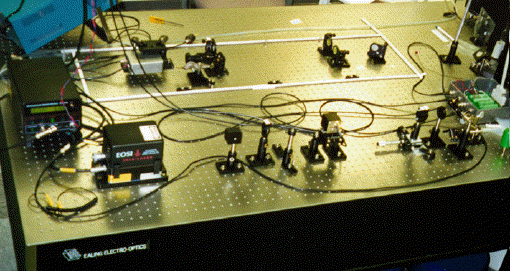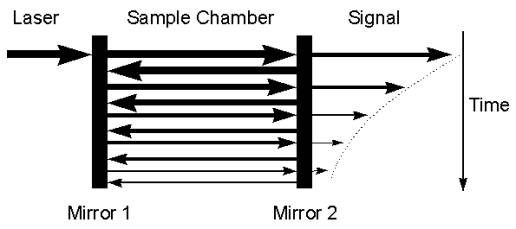Cavity
Ring-Down Spectroscopy- The Methodology of the Experiment
Direct absorption
spectroscopy of atoms and molecules in the gas phase, yielding both quantitative
absolute concentrations as well as absolute frequency-dependent cross-sections,
is a very powerful tool in analytical chemistry and physical chemistry. This
absoluteness is the reason why sensitive absorption spectroscopy techniques have
gained renewed interest, even in research fields where more sophisticated
laser-based diagnostic techniques are commonly applied. Among the various direct
absorption techniques, the cavity ring-down (CRD) technique has proven to be a
valuable addition, since it combines a good sensitivity with a rather simple and
straightforward experimental set-up.

Typical
optical chain applied in CRDS experiment
In a `conventional
’ absorption experiment, one measures the amount of light that is transmitted
through a sample. If the light source is monochromatic (e.g. a laser), one can
record an absorption spectrum of the sample by recording the transmitted
intensity as a function of the frequency. Alternatively, a broad light source
can be used when the incident light or the transmitted light is spectrally
dispersed. A drawback of direct absorption might be its limited sensitivity. A
small attenuation in transmitted light has to be measured on top of a large
background. High sensitivity is obtained by using modulation schemes and by
increasing the absorption path length. Alternatively, other experimental
spectroscopy techniques can be used which are based on the detection of
phenomena which are induced by absorption of light, such as pressure changes in
photoacoustic spectroscopy, fluorescence in laser-induced
fluorescence (LIF), or ions in resonant enhanced multiphoton ionization
(REMPI). The great advantage of these techniques is that they are background
free. A disadvantage is the sometimes difficult calibration procedure which is
needed to make these techniques absolute (i.e. these techniques are not
self-calibrating). CRD spectroscopy is a sensitive absorption technique in which
the rate of absorption rather than the magnitude of the absorption of a light
pulse confined in an optical cavity is measured. The sample is placed inside a
high-finesse optical cavity consisting of two highly reflective mirrors. A short
laser pulse is coupled into the cavity, the light is reflected back and forth
inside the cavity and, every time that the light is reflected, a small fraction
of this light leaks out of the cavity. Instead of measuring the total intensity
of the light exiting the cavity, one determines the decay time by measuring the
time dependence of the light leaking out of the cavity. In this way the rate of
absorption can be obtained ; the more the sample absorbs, the shorter is the
measured decay time.

The
Schematics of the operating principle of Cavity Ring-Down Spectroscopy.
There
are several advantages to this approach. Since the absorption is determined from
the time behaviour of the signal, it is independent of pulse-to-pulse
fluctuations of the laser. Furthermore, the effective absorption path length,
which depends on the reflectivity of the cavity mirrors, can be very long (up to
several kilometres), while the sample volume can be kept rather small. Compared
with other sensitive absorption techniques, especially those using modulation
schemes, CRD spectroscopy has the additional advantage that the absorption is
measured on an absolute scale. Another attractive property is its simplicity, it
is rather easy to construct a CRD set-up out of a few components.